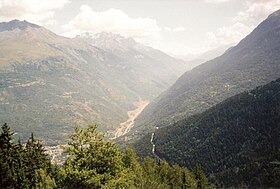This article includes a list of references, related reading, or external links, but its sources remain unclear because it lacks inline citations. (September 2010) |
Col du Télégraphe is a mountain pass in the French Alps situated above the Maurienne valley between the eastern end of the massif d'Arvan-Villards and the massif des Cerces.
| Col du Télégraphe | |
|---|---|
 | |
| Elevation | 1,566 m (5,138 ft) |
| Location | Auvergne-Rhone-Alpes, France |
| Range | Graian Alps |
| Coordinates | 45°12′9″N 6°26′40″E / 45.20250°N 6.44444°E |
The pass links Saint-Michel-de-Maurienne to the north and Valloire to the south, as well as forming an access point to the col du Galibier via its north face.
The route is often used during the ascent to Col du Galibier in the Tour de France, and is thus popular with cyclists.
Details of the climb
editFrom the north, starting at Saint-Michel-de-Maurienne, the climb is 11.8 kilometres (7.3 mi) long, gaining 856 metres (2,808 ft) in height (an average of 7.3%). The maximum gradient is 9.8% at the summit. On this side mountain pass cycling milestones are placed every kilometre. They indicate the current height, the distance to the summit, the average slope in the following kilometre, and the number of the street. As of July 2015, some milestones are missing in the middle part of the climb.
From the south, the climb starts at Valloire and is 4.8 kilometres (3.0 mi) long at an average gradient of 3.4% (height gain: 165 metres (541 ft)).
The Tour de France
editThe Col du Télégraphe was first used in the Tour de France in 1911; the first rider over the summit was Emile Georget.
Since 1947, the Col du Télégraphe has been crossed 29 times by the Tour de France. On several of those occasions it has not been ranked for points in the King of the Mountains competition, being treated as part of the descent from the Col du Galibier, and has been ranked for points only 18 times.
Appearances in the Tour de France (since 1947)
editSee also
edit- Fort du Télégraphe, the fortification at the crest of the pass, the location of the semaphore station that gave the pass its name
- Souvenir Henri Desgrange
